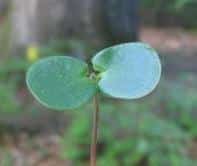The etymology of cotyledon takes us to a Greek word that refers to that which is cup -shaped. This term came to Latin as cotylēdon .
We have to state that this Latin word has been used since the 1st century to refer to a plant called the navel of Venus. Specifically, we would have to wait until the 18th century, specifically until the year 1751, for Linnaeus to give it the meaning with which we use and understand it today.
 In the field of botany , the first leaf that emerges in the embryo of a phanerogamous plant is called a cotyledon. These plants are those that have visible reproductive organs in the flower, where fertilization takes place and the development of the seeds that house the embryos of the new specimens takes place.
In the field of botany , the first leaf that emerges in the embryo of a phanerogamous plant is called a cotyledon. These plants are those that have visible reproductive organs in the flower, where fertilization takes place and the development of the seeds that house the embryos of the new specimens takes place.
The first leaves of these embryos are called cotyledons. In seedlings (name of plants as soon as they emerge from the seed ), the cotyledons can be differentiated from the rest of the leaves by size . On the other hand, cotyledons have characteristics that secondary leaves do not have, such as the ability to develop the digestion of albumen (the tissue found around the embryo and that is used as food after germination) or the fact of having different nutrients.
In addition to all of the above, we cannot ignore the fact that, depending on where these cotyledons appear, plants are classified into two different types:
-Hypogeals are those in which the aforementioned cotyledons appear underground.
-Epigean plants are those that are characterized because they are born outside of what the earth is.
Of course, regardless of whether they come out of or into the ground, the cotyledons continue to have the same function. And it is none other than feeding the seedling.
Plants that have seeds with a single cotyledon are known as monocotyledons . Corn, wheat, orchid and bamboo are some of the monocotyledonous plants. In this group we can also include orchids or palm trees.
Dicotyledons , on the other hand, have two cotyledons. Magnolia, avocado, cinnamon and rose are part of the group of dicotyledonous plants.
It is important to keep in mind that the cotyledons have a limited life: when the plant has already managed to develop the leaves that allow it to obtain energy , they end up falling.
In the same way, we can highlight other relevant aspects about cotyledons such as the following:
-Their development takes place during what is known as embryogenesis , which is made up of two phases: in the first, mitosis occurs, that is, the increase in the number of cells and in the second, what is called cell expansion.
-Among the nutrients that cotyledons possess and that make them different from other leaves of a plant are both starch and oil.
